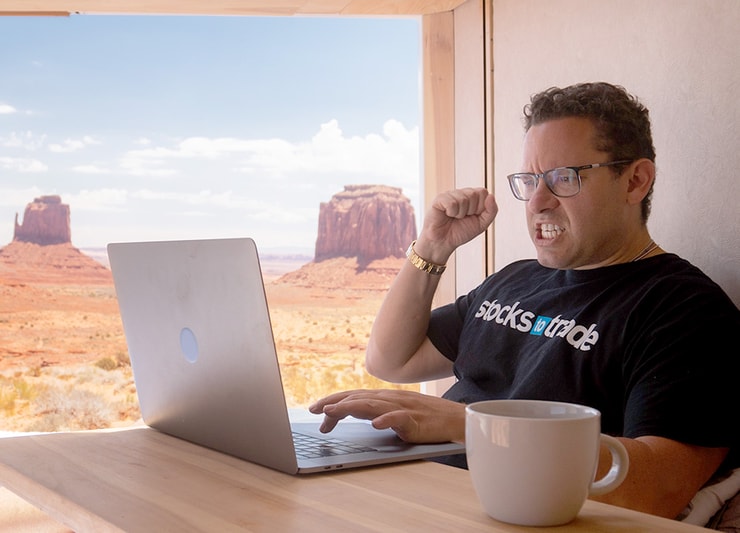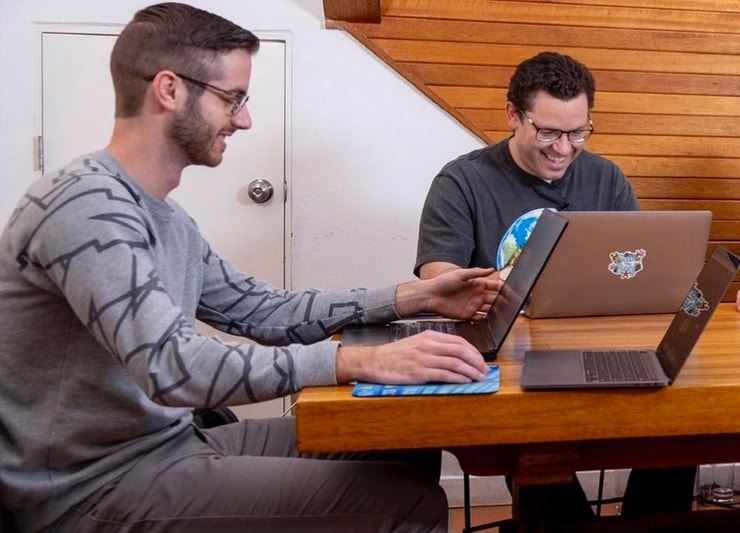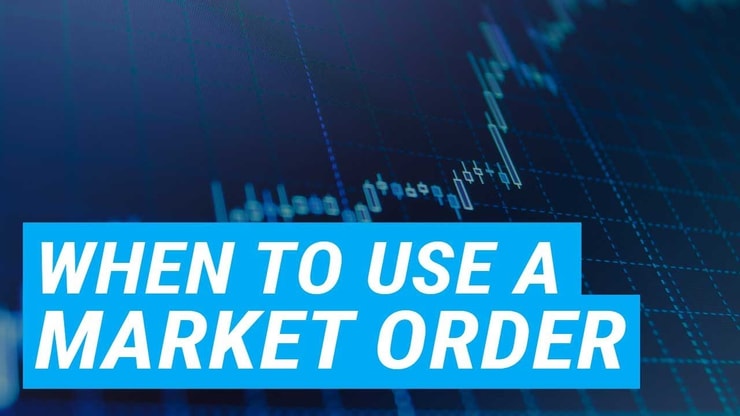If you want to find consistency as a penny stock trader, never assume that something is so basic that you can brush over it. That includes the bid and ask.
Start with the basics first. It’s how you build a better knowledge account. Don’t underestimate how valuable your education is when it comes to the market.
Even if you’ve never traded stocks, you’ve used the concept of a bid and ask.
This post will give you a good basic understanding of the bid and ask prices, bid and ask size, and the bid-ask spread.
Let’s get to it…
Table of Contents
Bid and Ask

Here’s how it works in the stock market:
- The bid is the highest current price on record that a trader is willing to pay for one share.
- The ask is the current lowest price on record that a trader’s willing to accept for one share.
It’s important to understand that there are other bid and ask prices in the order book or queue. They’re waiting for the current price to get knocked off by an order execution or another trader to offer a higher bid or a lower ask.
To understand this, you have to be clear on how buying and selling work.
So let’s get into some basics…
What’s the Difference Between Bid and Ask?
What does bid mean? It’s the amount someone’s willing to pay to buy something. Think auctions when someone bids on an item. But it can be anything — a house, a car, or a share in a company.
The asking price, or ask, is the price that a seller wants in exchange for an item.
Let’s take a look at an example to put a bid and ask into a familiar context.
How Buying and Selling Work
Let’s say you want to buy a house … You’d look for a house for sale in your price range. The price the house lists for is the seller’s asking price. That’s the ask.
But you think you can get the house for less. So you put in an offer, or a bid. If it’s a buyers’ market, you may get the house for less than the seller’s asking.
However, if you’re in a hot real estate market with lots of buyers and not as many houses to choose from, you’d likely offer the seller the full asking price or maybe more.
Buying and Selling Stocks
In essence, buying and selling on the stock market is the same. Buyers put in bids for the price they want to buy the shares for, and the sellers put in an ask for shares they want to sell. If a stock is in high demand, buyers will buy at the ask price.
If there’s low demand and a lot of supply, then the sellers will sell to the buyers on the bid.
However, just like when negotiating the sale of a house, a real estate professional is sometimes needed to bring the parties together … In the stock market, it’s a market maker who brings buyers and sellers together between the bid and ask.
For more in-depth information on market basics, check out my free penny stock guide.
When to Focus on Bid and Ask Prices
Now we’re getting to the good stuff. But this is where it can get a little complex, so I’ll cover the basics.
Quick note: Nearly everything you need to know about bid and ask is in “The Complete Penny Stock Course” by my student Jamil Ben Alluch (I wrote the forward). That includes an in-depth explanation of what I’m about to share with you.
At the most basic level, you should focus on the bid and ask when the price is:
- Close to key support or resistance levels.
- Close to your planned profit or loss targets.
- Close to daily highs or lows.
As you get deeper into your trading education, you’ll learn about Level 2. That’s a data feed that provides real-time trade details. You can use it to see the order book or queue (including bid, ask, and order size) for any given stock.
What Factors Affect Bid Price and Ask Price?

More Breaking News
- Is Opendoor Technologies Headed for a Stock Surge After Robust Earnings Beat?
- Sunnova Energy’s Surge: An Opportunity or a Bubble Waiting to Burst?
- How Intuitive Machines’ Recent Partnerships and Earnings Propel Its Stock
Volume
Volume is the number of stock shares that trade in a given time frame. I prefer to trade stocks that have higher-than-average volume for the day.
Stocks with no volume usually have large bid-ask spreads. That means there’s a large price gap between the bid and ask. So you’ll either be buying high to get in or selling low to get out.
Liquidity
The amount of volume creates liquidity — how easy it is to get out in and out of a position. When a stock has lots of volume, there are a lot of buyers and sellers to move the price around.
With high liquidity the bid and ask prices are usually much closer together.
Now you know the basics of buying and selling. But did you know there are different types of stock orders? This is crucial information. Let’s check it out…
Examples of Order Types to Execute on the Bid and Ask
#1 Market Order
When you place a market order, your order executes at the recorded price at the time of execution. This applies to both buying (you pay the current ask) and selling (you receive the current bid).
The amount you actually pay is determined by the ask price when your order executes.
With a market order, you pay the ask price — the lowest recorded available price — when your order reaches the front of the queue.
As a penny stock day trader, I never trade using market orders. The reason? I don’t have control over the purchase price.
If the price moves the wrong way fast, my order could execute far outside my planned trade setup. There’s also the potential for price manipulation by market makers.
#2 Limit Orders
This is the type of order I use and teach my students to use. With a limit order, you set the price at which your order will be executed. Your broker has to execute your order at your limit price (or better). If the order can’t be executed at your limit price, it won’t get executed.
Plus, you can cancel a limit order at any time before it gets filled. This means you can decide to wait for the price to come to you. Or, if the bid and ask prices move away from your limit, you can cancel.
A limit order means your position might not get filled (or might get partially filled). But it also ensures that you won’t trade at a price outside your trading plan.
#3 Understanding Spreads
A close spread is a sign of relative stability in a stock’s price. The bigger the spread, the greater the volatility.
A market maker is a kind of broker or dealer who brings liquidity to the market by filling orders. They make a profit by taking advantage of the bid-ask spread. With the development of electronic trading, a matching engine fills most orders. It matches buy and sell orders electronically.
Market makers can fill orders between the bid and the ask. This can happen for a number of reasons. One common reason is that a market maker purchases or sells shares between the bid and ask to help maintain liquidity.
So how does the market maker profit from the spread? Good question.
Market makers take on risk by holding shares to buy or sell. They can disperse their shares between the bid and the ask and profit on the difference.
#4 Bid and Ask Size
The bid size is the number of shares a buyer (or market maker) is willing to buy at the bid price. The higher the bid size, the more shares traders are willing to buy at that price.
The ask size is the number of shares a seller is willing to sell at the ask price. The higher the ask size, the more shares that are available from traders who want to sell at that price.
Both bid and ask sizes can also limit the number of shares you can buy at any given price. This is important. When I talk about getting partial execution, this is what I’m talking about.
Let’s say you try to buy 5,000 shares of a stock at $1, but the ask size at $1 is 2,000 shares. The next lowest ask is $1.05. For you to buy all 5,000 shares you’d have to pay more for the 3,000 extra shares you need to fill your order.
Let’s make this super clear … Since you’re using a limit order, your order will be partially executed. You get the 2,000 shares at the price ($1) you want. If you’re buying into a multi-month breakout and your trading plan allows for it, you can buy the other shares at a higher price…
But you have to place another limit order at the higher price.
Importance of Bid-Ask Size
Bid and ask size are important for a few reasons…
If there’s a discrepancy between the total bid and ask sizes, filling orders becomes difficult. In most cases, market makers or specialists will step in and buy or sell shares to maintain liquidity. Otherwise, the imbalance can force a halt in trading.
Bid and ask sizes give you an indication of supply versus demand. If bid sizes are higher than ask sizes, the buyers have strength at a given price.
The opposite is true for ask sizes: If ask sizes are higher than bid sizes, sellers have strength at a given price.
If you’re looking to dig deeper into how bid and ask sizes can influence trading decisions, our partner blog CheddarFlow offers a great explanation. Their blog post on bid-ask spreads for options trading breaks down how these sizes can affect options trades and strategies.
Bid-Ask Spread in Options
The bid-ask spread in options can be much larger because options tend to be less liquid. If you’re unfamiliar with options, they’re a financial instrument that gives you the right to buy shares at a certain price before a certain date.
Options are usually more liquid if the underlying stock is liquid.
This is an entirely different game from penny stocks. And options aren’t my thing. But there’s one thing that options trading and trading penny stocks have in common: Preparation is key.
So while I’d rather see you learn to trade penny stocks, if you choose to get into options then educate yourself and study like crazy.
See these posts:
- Day Trading Options Guide: How to Find Better Options Trades
- Options Trading Basics: Strategies and Examples of How it Works
My top student Mark Crooke has evolved into an options trader. Check out what he’s learned in this webinar and how you can learn from him.
Take Advantage of StocksToTrade Features
It’s no secret that I’m a huge fan of StocksToTrade. I helped design the platform and I’m an investor. It has so many cool features, I could easily double the length of this post.
Since this post is about bid and ask, I want to share a video (3 minutes and 13 seconds of pure awesomeness) featuring my colleague Tim Bohen. Tim is the lead trainer for StocksToTrade’s mentorship program, SteadyTrade Team.
Watch the video because the Level 2 Book Entry bar is ALL about bid and ask live data.
Once you set up your StocksToTrade account, make sure you spend time watching Tim Bohen’s training videos. They can help reduce the time it takes you to get familiar with the platform. His videos are excellent.
You can get a 14-day trial for just $7 today.
Bid and Ask Spread Trading Strategies
The best-known strategy for trading the bid-ask spread is scalping. These traders attempt to buy a security on the bid and sell it on the ask, taking advantage of the spread.
But other buyers and sellers have to fill their orders for this strategy to work.
Scalping involves multiple trades within a day, sometimes on the same security again and again. This isn’t a strategy I recommend. You can end up holding a stock and not being able to sell your position unless it’s for a large loss.
What Is Best Bid and Best Ask?

The best bid is the highest price a buyer is willing to pay for the security. The best ask is the lowest price that a seller’s willing to accept.
Other orders below the best bid or above the best ask sit in the queue until traders buy up all the available shares at the best ask or sell into all the best bids.
Frequently Asked Questions About Bid vs. Ask
Why Is the Bid Higher Than the Ask?
If the bid volume is higher than the ask, it shows there’s demand for the stock and the price will likely go up. If there’s an order for a higher price than the ask, it will likely get executed at the ask price or above if the price is moving up quickly.
Can I Buy a Stock Below the Ask Price?
Yes, with a limit order you can set the amount you’re willing to pay for the shares you want. But your order will only get filled if the stock hits your bid price.
Who Benefits from the Bid-Ask Spread?
Market makers can potentially profit from the difference between the bid and ask by selling some of their own shares and collecting the difference.
What Are the Roles of Bid Price and Ask Price in Liquidity?
If the bid price and ask price are close together it usually means the stock is very liquid or heavily traded. This means you can have a better chance of getting your order filled at the price you want to pay or receive.
What Are the Numbers Beside the Bid and Ask?
The number beside the bid is the number of shares traders want at that price or the bid size. The number beside the ask is the number of shares selling at that price, known as the ask size.
What Does It Mean When the Bid and Ask Are Close?
When the bid and ask are close to the same amount, it means there’s volume and liquidity in the stock. It also means there won’t be such dramatic price swings with each buy and sell.
Conclusion About Bid and Ask
Bid and ask for stocks is the equivalent of an offer and an asking price. These are terms you should not only know but understand thoroughly. Study, study, study. And then study some more.
I suggest you get a StocksToTrade subscription if you don’t already have one. Then spend some time paper trading to learn how things work. Get a Level 2 subscription — that way you can see all the action and start to understand entry and exit points better.
I also encourage you to apply for the Trading Challenge. That’s where I teach you how to take advantage of the information in this post and so much more. It’s where you can work to become a self-sufficient trader.
How do you use bid and ask in your trading setups? Let me and your fellow traders know. Leave a comment!





Leave a reply